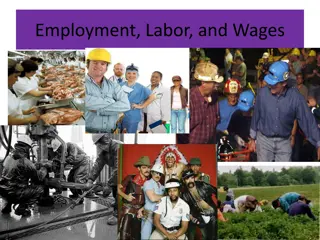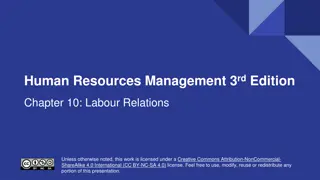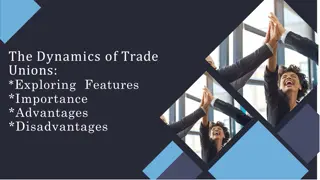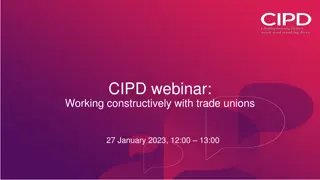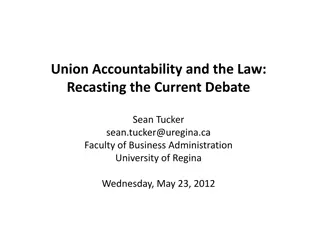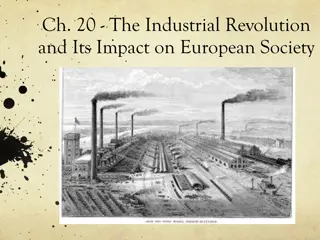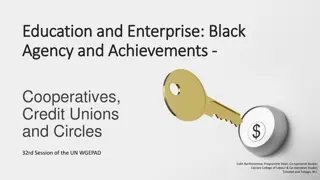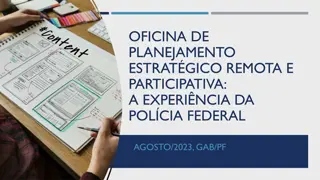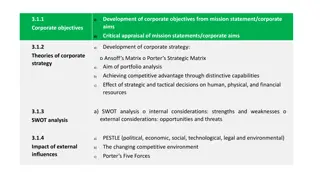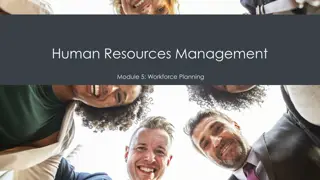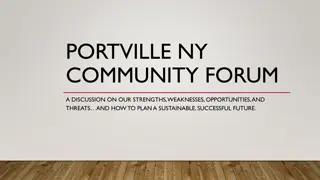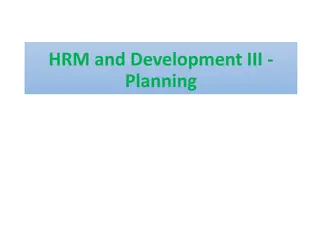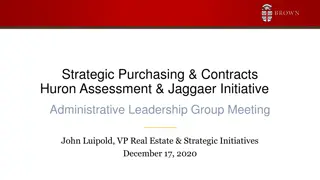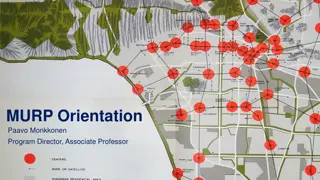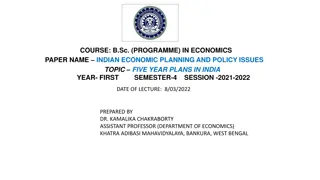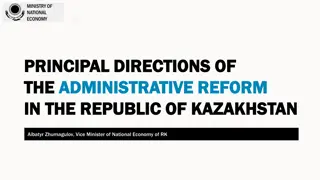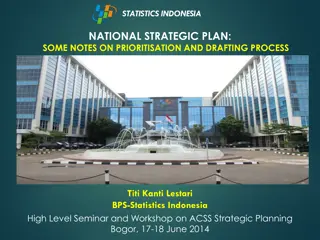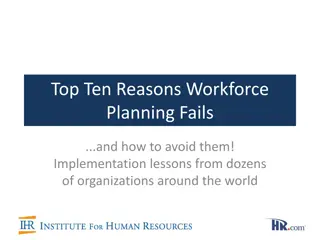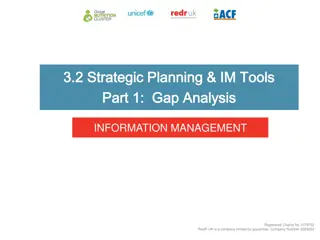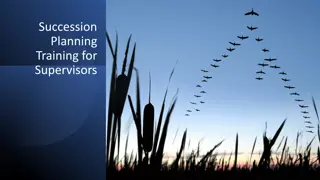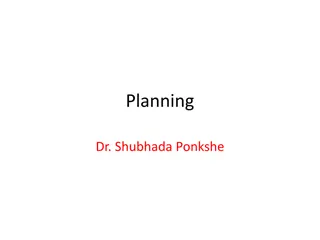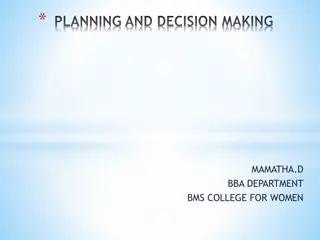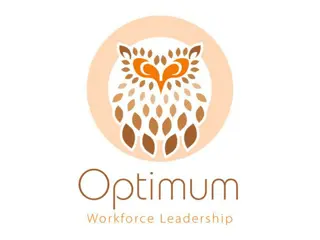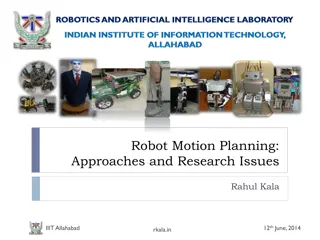Importance of Strategic Planning for Unions in Today's World
Strategic planning is crucial for unions in navigating the complexities of today's environment. Without a clear strategy, a union may struggle to achieve its goals and respond effectively to external influences. Strategic planning goes beyond reactive approaches, providing a roadmap for success by establishing long-term objectives and defining steps to reach them. This process enables unions to set priorities, make informed decisions, and drive purposeful action, ultimately shaping the direction of the organization and its impact on members and the community.
Download Presentation

Please find below an Image/Link to download the presentation.
The content on the website is provided AS IS for your information and personal use only. It may not be sold, licensed, or shared on other websites without obtaining consent from the author. Download presentation by click this link. If you encounter any issues during the download, it is possible that the publisher has removed the file from their server.
E N D
Presentation Transcript
Strategic planning for unions ITF Women s Development Programme
Whats your experience with strategic planning? Does your union have a strategic plan? Strategic planning The good The bad The expensive The forgotten
Strategic planning a road map If you don t know where you are going, any road will do but you may discover that you have little control over where you end up. In today s world, where all other organisations and institutions are planning (and where many of their plans include actions that will impact on your union and your members) a union without a strategy and a clear vision about what it wishes to achieve is not likely to be successful.
Strategic planning beyond reacting All too often unions simply react to management and government initiatives, or seek short-term objectives. Most unions do some planning mostly around a schedule dictated by their regular duties: disputes, handling grievances, contract negotiations, regular union meetings, elections, political lobbying, organising, and participating in labour bodies conferences and various other activities which are all part of the regular demands of union life.
Strategic planning means looking beyond these important activities and analysing your situation to develop long-range goals, and working out the specific steps to get from where you currently are to where you need to be.
Strategic planning charts a course to organise what we have, to acquire what we need, to get what we want
Why make strategic plans? Acore leadership skill. Requires you to ask and answer questions important to the organisation. Enables you to set goals and forces you to set priorities. Provides both a framework for decision making and a basis for measuring performance. Makes the organisation purposeful and sets direction for the union, its members and the community it seeks to influence.
Why make strategic plans? For unions, as democratic organisations, strategic planning provides a vehicle for involving the board, staff and members of the union to develop a common framework and language about problems central to the future of their organisation. Planning requires the union to take a systems approach with an emphasis on action rather than reaction.
The best way to predict the future is to create it and strategic planning is participating in the creation of the future.
What is strategic planning? Substantive definition: A systematic method for making decisions about a union s future. Process definition: A systematic method for engaging all decision-makers in the union in understanding what is required for the future.
What strategic planning is not Just process, no substance Just substance, no process Megatrends Endless crafting of a mission statement
Strategic planning process 5 basic steps 1. Mission/vision/values/objectives 2. Assess the current environment (Strengths/ 3. Weaknesses, Opportunities/Threats SWOT). 4. Develop priorities and goals 5. Action plan 6. Evaluate
1. Mission/vision/values The mission is the motivating purpose behind your entire plan. It s tempting to skip this step and view the real core of strategic planning as defining a plan and creating action steps for executing the plan. However, the real challenge that unions face often isn t the lack of a good plan but motivating members to participate in the plan! Why does our union matter at this moment in time? What does the union want to accomplish in the broadest sense? And why does this matter not only to members but to the community at large?
1. Mission/vision/value Values consist of opinions about what is right, fair, or just. They describe the ideas that matter most to people, the things that they will make sacrifices for in order to obtain them. Beliefs are the basic assumptions on which we base decisions. They include our assumptions about people, power, what makes things happen, etc. Togethervalues and beliefs determine the goals towards which the organisation should be directed, and by which its success and worth should be measured.
Unions beyond wages & benefits Organisation for winning rights Vehicle for exercising rights Schools for democracy the right to participate in decisions that affect you Builders of a community of interest among members, and with the wider community Provides Voice versus exit providing management with valuable feedback essential for systems improvement Premier institution of civil society, promoting democracy in the workplace, economic and social justice and equality
Your campaign mission statement Write a mission statement you can actually use in day-to-day conversations!Union leaders and activists are called upon to define the union every day in interactions with new employees, members and potential members, community allies, and elected officials. In today s hostile environment, it is vital that we develop new ways of talking about ourselves, our organisation and our values.
1. Mission/Vision/Objectives Elements to consider: Who we are Why we exist (purpose) Who we serve (members but also other stakeholders) How we accomplish our goals (key strategies and core competencies) What results (products, services, changes) Guiding principles (values, beliefs, culture)
2. SWOT assessment Crucial to your planning process is an environmental analysis assessing the external and internal environment within which your union operates. This type of analysis used in strategic planning is called a SWOT (strengths/weakness, opportunities/threats) analysis.
SWOT assessment Helps to: Isolate key issues to resolve Focus activity into areas where you are strong and where the greatest opportunities lie Consider factors from an internal as well as external point of view Support a comprehensive, thoughtful, and strategic approach to information that may have an impact on the identified goals Help elicit information from different points of view. The more perspectives involved the more useful the information Identify barriers to success Develop priorities for action
SWOT analysis internal Overall state of your organisation? How many members do you have and what proportion of the total workforce does that represent? Workforce makeup (demographics such as males/females, age, divisions)? Your unions relationship with other organisations that may be important to your success? Your union s human resource/people system (training and promotion of members as leaders)? Level of member involvement, willingness of members to become active in campaigns, and development of new leaders? Skills of volunteers, staff and members? Numbers and composition of your members who are active in the union? How many participated in your union s last major activity? Skills of your leaders and staff in relation to challenges that you face? Culture of the organisation? How does the culture of the union impact what members believe is appropriate and inappropriate for the union. Who are the heroes in your organisation? What are the least appreciated roles within the union? What questions might you add to aid in this assessment?
SWOT analysis external Moving on to the external environment we need to examine those forces outside your direct control that impact significantly on your union and need to be considered in your strategic planning. Again, we are interested in not just the current situation but in trends. A short acronym might help us to remember key elements of the external environment that need to be taken into account. PEST stands for Political, Economic, Social and Technology factors. Political/Legal Economic Social Technology
SWOT analysis external Political Few union members would deny the importance of politics, regulation and legislative decisions. Political leaders and their decisions have tremendous impact on our work and our future. Who are your political allies and who are your opponents? What are the key issues that we need to face politically? Economic How does the current economic environment affect us? Are there global economic trends that will have an impact on our situation? Social What is the public attitude to unions and the work our members do? Are there important community institutions that we need to have onside or develop relationships with? Technology how might changes in technology, not just machines and tools, but work organisation and work processes affect us?
3. Developing priorities and goals Setting priorities is about making choices putting first things first. You can t do everything, and too often new goals are simply added to existing projects, with members becoming demoralised by the failure to prioritise. In the SWOT analysis you were forced to prioritise that is choose the four most important Strengths and Weaknesses and the four most important Opportunities and Threats. But 16 items is hardly a priority it s more like a shopping list. So now, we need to further focus our thinking to very specific goals we wish to achieve in a specific period of time.
Goal setting Goal setting is a vital step in carrying out your union s mission. Goals should be specific achievements you wish to accomplish and should relate to your priorities. State each goal in a brief sentence. You might want to think about some as short-term goals and others as long-term goals. Short-term goals are the immediate steps to start the union moving towards its mission. It is often things that must be accomplished over the next few months. Long-term goals will indicate where you would like to be, in relation to your mission, in the months and years ahead. Your goals will depend on where you are now and what is realistic to accomplish in a certain period of time, such as within a year. Think broadly, but start with the basics. You can always add more goals later.
Your goals will depend on where you are now and what is realistic to accomplish in a certain period of time, such as within a year. Think broadly, but start with the basics. You can always add more goals later. State the goal as specifically as possible. If trying to change individual behavior, performance-oriented goals are more useful. Goals must be attainable or they will guarantee frustration. Goals represent hopes people want to observe results. Goals must be clear to those who are affected by them. Goals must be acceptable to those affected. Because you cannot always determine clear, acceptable and attainable goals in advance, you must be able to modify your goals.
4. ACTION PLANNING To convert goals to strategies and actions, it s important to be specific! Most strategic planning approaches include a reference to SMART goals, objectives, and action plans in other words, they should be: Specific Measurable Agreed Realistic Time-bound
Motivation to get involved Action inhibiters: Inertia Fear Apathy Self-doubt Isolation Action facilitators: Urgency Hope Anger (love, joy) YCMAD (You can make a difference) Solidarity
Action Strategy This is our plan of action for turning what we have into what we need to get what we want. It is how we mobilise and deploy resources to achieve goals the use of power. The key to mobilising resources is commitment, beginning with ourselves.
ACTION PLANNING Chart possible strategies and actions for achieving each goal. You ve assessed the current environment, looking at the external threats and opportunities that exist, as well as your union s strengths and weaknesses. You ve identified which goals are currently priorities for your organisation. Use the chart to develop an action plan for the goals you ve identified as priorities for your union.
5. EVALUATION & IMPLEMENTATION Don t overlook the evaluation.If an action didn t work, find out why. The advantage of a written action plan is that you have a clearly stated action and performance expectation for your evaluation and consideration. Does the strategy need to change? If the action worked, publicise your victories, and show the progress you are making toward your goal. Find ways to recognise the work of volunteers. Has the environment changed? Are there new opportunities that have opened that you can now take advantage of? Are there new threats on the horizon? Are you continuing to involve new people in your local or are you returning to the same people continually?
Eight steps in organisational transformation 1. Create a sense of urgency 2. Powerful guiding coalition 3. Create a vision 4. Communicate the vision 5. Empower others to act on the vision 6. Create short-term wins 7. Produce more change & consolidate improvements 8. Institutionalise new approaches
THE BEST WAY TO PREDICT THE FUTURE IS TO CREATE IT


